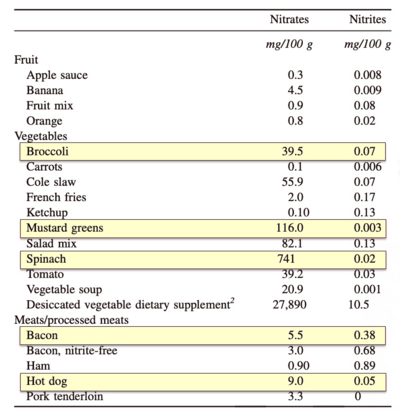Why our sausages and bacon are traditionally cured, with nitrates.

Nitrates and nitrites in processed meats

Nitrates and nitrites are used in the production of processed meats like bacon, salami, and ham. However, they are also found naturally in many plant foods, often in very high amounts. For example, pound for pound, spinach contains at least 30 times more of these compounds than hot dogs do (see table above). In fact, some manufacturers of processed meats boast that they use celery powder (very high in nitrate), instead of the more commonly used sodium nitrite to preserve their meats.
What is the difference between nitrates and nitrites?
It can be confusing because these terms are often used interchangeably by food manufacturers, physicians, and nutritionists. The reason why people lump them together so often is because nitrates easily turn into nitrites in foods and in the body. Nitrates and nitrites are very similar chemical salts with very similar properties, and mixtures of nitrates and nitrites are often used in food processing. Nitrites are about three times more potent than nitrates as preservatives.
Why do use these compounds to preserve meat products?
In combination with salt, nitrates and nitrites prevent the growth of the bacteria that causes botulism (a type of food poisoning). They also act as antioxidants, keeping the fat in the meat from turning rancid, and giving the meat an unnatural pink color. Nitrates and nitrites themselves have not been shown to cause cancer; however, they can react with proteins in the meat to form nitrosamines, which are known to cause cancer in laboratory animals, however the evidence that this effect occurs in humans is weak and based on epidemiological studies that require self reporting and fail to account for other factors, in other works correlation has been found but not causation.
So should we avoid these compounds?
If you're actually worried about nitrates then it's not just bacon, salami and hams you should avoid but you need to limit intake of vegetables that are very high in nitrates, such as spinach and celery. Bacteria in our saliva convert vegetable nitrates into nitrites, which we swallow. These nitrites can then react with proteins in our stomach to form nitrosamines, exactly the same way they do during meat processing.
Nitrosamines are organic compounds of the chemical structure R₂N−N=O, where R is usually an alkyl group. They feature a nitroso group bonded to a deprotonated amine. Most nitrosamines are carcinogenic in nonhuman animals.
Endogenous nitrosamine formation can be affected by ascorbic acid,[14] either inhibiting its formation or increasing its formation, depending upon whether ascorbic acid is consumed in conjunction with it as opposed to the effect being reversed by factors related to dietary fat consumed at the same time.
In the case of formation of carcinogenic nitrosamines in the stomach from dietary nitrite (used as a processed meat preservative), ascorbic acid (vitamin C) markedly decreases nitrosamine formation in the absence of fat in the meal, through inhibition. However, when 10% of the meal is fat, the effect is reversed, such that ascorbic acid then markedly increases nitrosamine formation, the take away form this? Eat your lean processed mets with veggies, eat the fatty ones without, perhaps?


